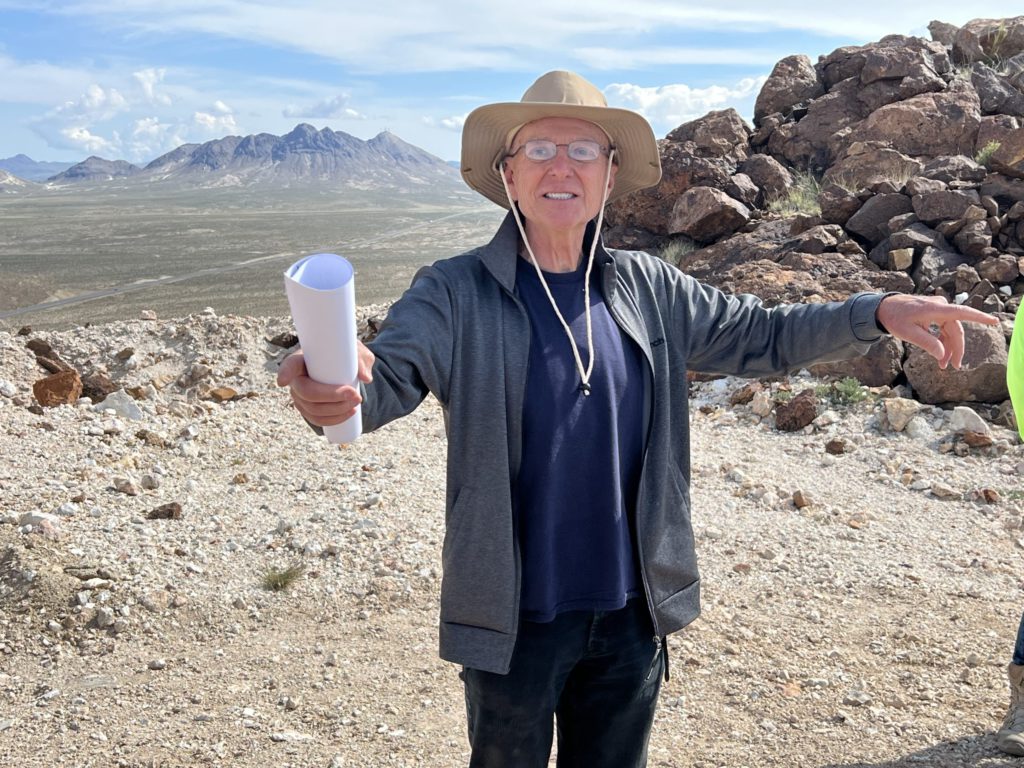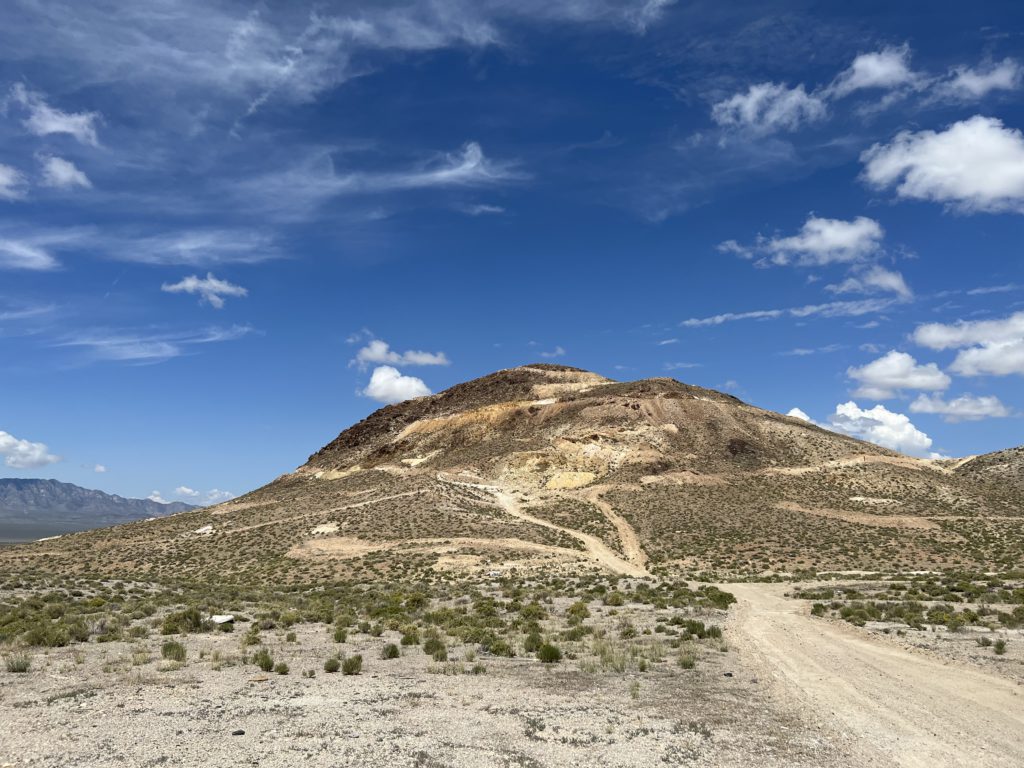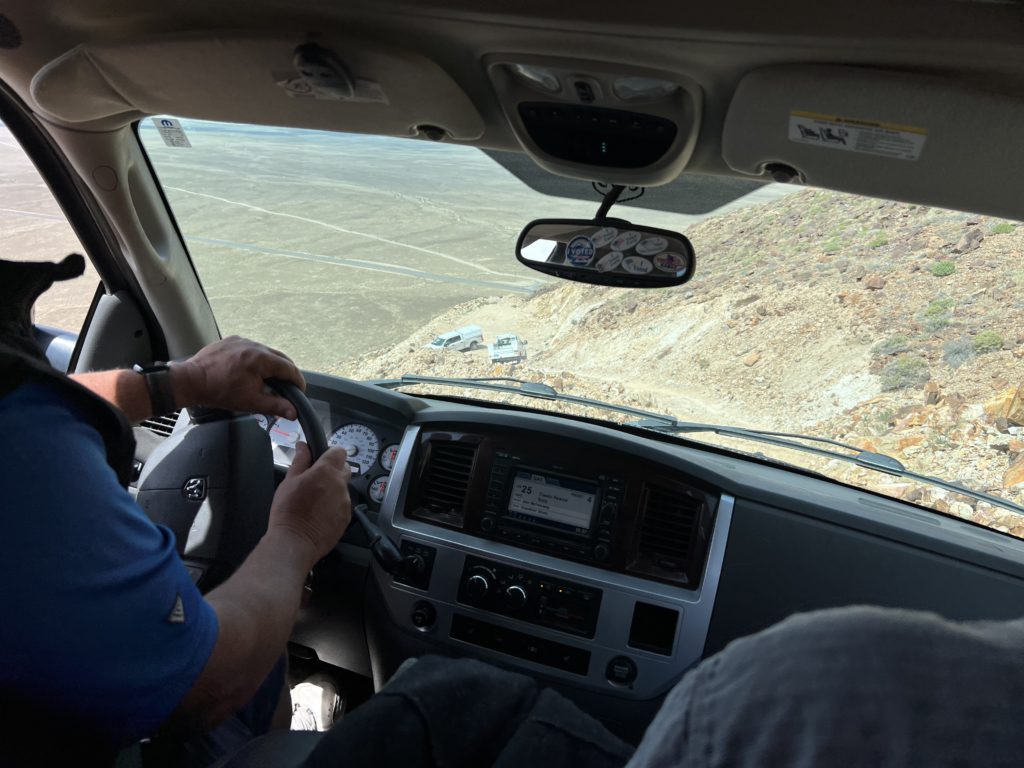
West Vault Mining’s (TSXV: WVM; US-OTCQX: WVMDF) Hasbrouck gold project in Tonopah, Nevada stands out among the wave of gold, silver and lithium explorers sinking exploration dollars into the Tonopah Silver District in that it is content to bide its time and do nothing.
The company views the project as similar to having gold stored securely in a vault – a project ready for construction, backed by favourable economics and a strategic approach, CEO Sandy McVey said on a recent site visit.
“We know that fewer gold discoveries are being made, and more gold is being produced yearly. Time’s on our side. Patience pays,” the mining veteran says.
With an advanced asset under its care, West Vault bides its time in the hope that regional consolidation would include the sale of its flagship pre-feasibility study level project for the right price.
Situated three hours north by paved road from Las Vegas, the three hills comprising the Hasbrouck project form a series of mineralized mounds standing guard as one enters Tonopah.
McVey says the project has resilience, and the in-situ value has remained the same and increased over time as the gold price gradually edges higher.
McVey mentioned West Vault’s strategy of acquiring undervalued assets, noting they bought of the Hasbrouck project from distressed conditions. This approach allows the company to capitalize on opportunities to buy assets at a low cost and potentially realize significant returns when market conditions improve.
“We bought [the Hasbrouck project] in 2014, and to date, it’s withstood deep dives by all sorts of people (including Centerra Gold) – resource geologists have redone it when we’ve restated mineral resources and so on,” McVey said from atop Hasbrouck Mountain, a short but exhilarating 4×4 drive up what will someday become an open pit right next to highway 95.
The brainchild of Peter Palmedo, chairman and president of Sun Valley Gold which owns 46% of the company, West Vault has groomed the project as far as its willing to pay for and put up the for sale signs.
A January feasibility study calculated an after-tax NPV (5% discount rate at $1,790 per oz. gold) of $206 million and an IRR of 51%.
The initial Three Hills operation will cost an estimated $66 million (and sustaining and growth capex of $156 million). Between the Three Hills and Hasbrouck Mountain deposits, the company has outlined potential total production of 561,000 oz. gold, or 71,000 oz. per year over eight years at all-in sustaining costs of $701 per oz. gold, net of by-product credits.
The study was based on proven and probable reserves of 44 million tons grading 4.8 grams gold per ton for 753,000 oz. of metal. About 175,000 oz. gold is held in the Three Hills deposit, with 578,000 oz. gold held in the Hasbrouck deposit.

McVey emphasizes the project’s advanced stage. “We’ve got wet stamp drawings, we’re way beyond study levels… state, federal – fully permitted,” he said.
At the heart of the project lies the Three Hills deposit that requires no pre-stripping. This smaller deposit has a 0.8 to 1 stripping ratio. Employing a straightforward run-of-mine heap leach method, West Vault anticipates a recovery rate north of 80%.
Adjacent to Three Hills, the Hasbrouck pit emerges as the project’s second phase. Though it presents a slightly higher stripping ratio of about 1.1 to 1 and necessitates crushing, the Hasbrouck pit holds a bigger promise. Operating for six years, followed by a two-year closure process.
McVey says free cash flow will pay for the subsequent development at Hasbrouck, especially in the current market, with gold prices hovering around $1,800 per ounce.
McVey says West Vault is significantly undervalued in the market, based on P/NAV benchmarking.
“This indicates that the company’s market capitalization is relatively low compared to its net asset value, presenting a potentially attractive investment opportunity,” McVey says. The P/NAV ratio provides insight into how the market values the company’s underlying assets relative to its current share price.
He says West Vault’s current market capitalization of about $46 million against its 561,000 oz. of in-situ gold equals to an opportunity to acquire a quality, albeit small, project for about $81 per ounce.
McVey has a somewhat unorthodox approach to maximizing value for shareholders. He states, “People think production is how you make money. It’s not. It’s buying low and selling high,” says McVey.
However, Hasbrouck, as a standalone operation, will probably not be developed if Palmedo has the final say. He is dead set on a sale, which arguably, according to back-of-napkin calculations, could mean the difference between capturing an IRR of 51%, or 550%.
Theoretically, the ideal candidate has already entered the valley. Centerra Gold (TSX: CG) swooped back onto the scene in early 2022, fresh from being kicked out of Kyrgyzstan and with about C$1 billion in cash burning its pocket (and possibly making it a takeover target for the cash). The gold miner splurged on the nearby Gemfields project, buying it for C$207 million from private capital firm Waterton Nevada Resources.

McVey breaks down the math: for 483,000 saleable oz., Centerra paid a total price of $427 per oz. gold, compared with West Vault’s current theoretical acquisition value of $81 per saleable oz., meaning it’s cheaper for more ounces than the Gemfield transaction at current prices.
“Bear in mind, Hasbrouck also has stronger economics than Gemfield, which at $1,300 per oz gold delivers a 46% IRR for Hasbrouck versus 20% for Gemfield,” McVey says.
However, Centerra may first want to get to grips with what they bought (could explain the drills visible from the roadside) at Gemfield, which they’re now busy drilling, before entertaining any further ideas of regional consolidation.
West Vault Mining eschews unnecessary drilling or exploration activities, focusing instead on positioning the project for potential sale.
By capitalizing on opportune moments when gold prices and market conditions align, the company aims to create value.
West Vault’s Hasbrouck project also holds potential for future expansion, with indications of a high-grade feeder system warranting further exploration when the time is ripe.
The Three Hills resources entail 10.4 million tons indicated at 5.1 grams gold per ton for 185,000 oz gold, and measured and indicated resources of 42 million ton grading 4.3 grams gold per ton for 651,000 oz gold and 8.2 grams silver per ton for 12.2 million oz of metal.
With nearly $4 million in the bank and a four-year runway ahead, the company is prepared to wait it out because conditions must turn – eventually.
At C92¢ per share on Friday, West Vault shares are down almost 10% over the 12-month period, having touched C83¢ and $1.15. As of Friday its market capitalization stood at C$53.5 million ($40.5m).